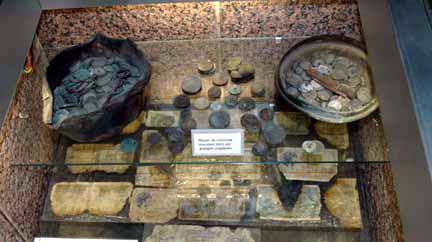The Crypt at Oradour-sur-Glane

The photo above shows the roof of the
Crypt, a sinister looking underground building which was originally
built as a tomb to hold the remains of the victims. In the center
of the photo is the open doorway into the crypt. Visitors descend
the stone stairs down into the dark interior. The only lighting
is on the displays. The first thing you see is the vestibule
in which baby carriages and children's bicycles are displayed.
The photo below shows the frames of a
baby carriage and a stroller, along with a child's baby buggy,
which are regarded as the relics of martrys. This photo was taken
with flash since the whole building is dark inside.

The crypt is very cool and dark, like
a morgue, giving one a creepy feeling. Near the door is a plaque
with a quotation from French writer Balzac: "Of all the
seeds entrusted to the earth, the blood shed by martyrs is that
which renders the most rapid harvest."
The photo below shows the display cases
which are in front of you as you enter. There are four museum-style
marble display cases, lit from below, which are arranged in an
octagonal shape. The building is too large for the small number
of display cases.

The relics in the display cases, shown
in the photo above, were gathered from the ruins. There is an
assortment of pocket watches, which were found after the barns
were burned. They are shown in the photo below. Among the displays
there is also paper money, a photo of the local soccer team,
a tobacco ration card, identity papers, and a number of pocket
knives that look like Swiss Army knives.

Accoding to Sarah Farmer, author of "Martyred
Village," the relics of the men are displayed separately
from the relics of the woman and children, reflecting the fact
that they were killed separately. Objects that belonged to the
women and children are displayed in glass cases along the walls
of the crypt, according to her book. However, the photo above
shows porcelain objects, which obviously belonged to the women,
in the same display case with the watches belonging to the men.
At the bottom of the photo below, you
can see some of the paper money that was only partially burned.
Before the men were killed, the soldiers spent some time plundering
the town, but they forgot to ask the men to empty their pockets
before they machine-gunned them to death. The soldiers also neglected
to rob the women before killing them, and a large quantity of
jewelry was found in the church.

In the photo below, you can see more
relics, including a flat iron which is in the lower left hand
corner. Apparently many of the houses didn't have electricity
and the women were still heating irons over wood-burning stoves.

In the words of Sarah Farmer who wrote
a book called "Martyred Villge," the displays in the
crypt "conjure up an innocent vision of the past."
After a trial in Bordeaux in 1953, the
perpetrators of the massacre, who had been convicted, were set
free. This angered the survivors who returned the Legion of Honor
with which the village had been decorated. According to Robert
Hebras, "The National Association of the Martyred Families
of Oradour rose in indignation at the flagrant injustice rendered
in the name of national unity; it made a mockery of the victims'
dignity. Oradour broke off all relations with the State and the
rupture lasted for 17 years. The Association was able to finance
a monument, erected in the cemetery, thanks to the large number
of donations that came from all over, and to exceptional terms
of payment granted by the company owned by Monsieur Dagoury,
who had, himself, lost all his family in the massacre. As for
the first memorial, after the reconciliation with the State,
it was turned into a museum, where a number of items found in
the ruins are displayed."
|